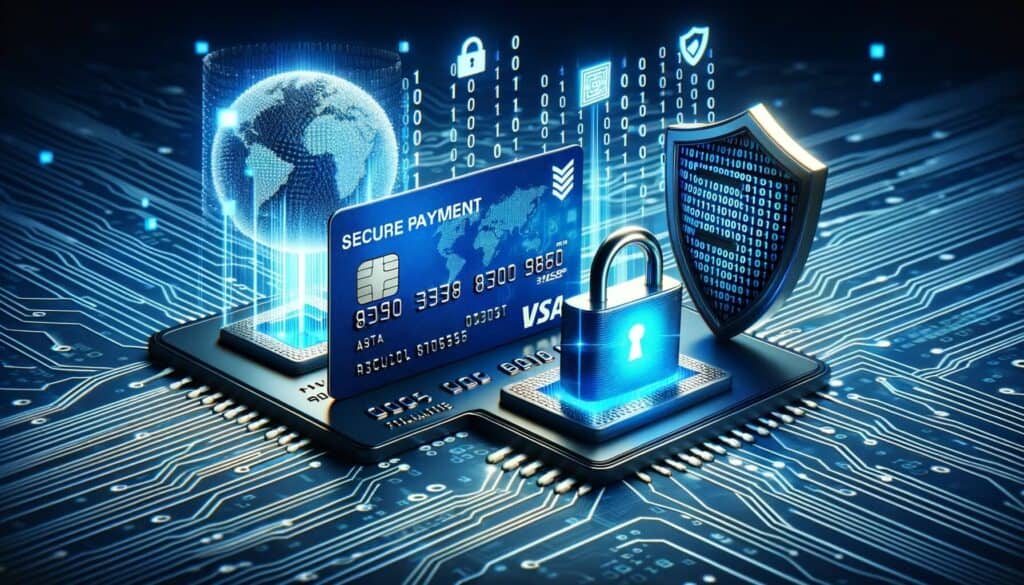
By Mollie Mills April 1, 2025
In today’s digital age, secure payment processing systems have become an essential component of any business that accepts online payments. These systems ensure that sensitive customer information, such as credit card details, is protected from unauthorized access and fraud.
In this comprehensive guide, we will explore everything you need to know about secure payment processing systems, including their importance, types, key features, and best practices for implementation.
Understanding the Importance of Secure Payment Processing

Secure payment processing is crucial for businesses as it helps build trust with customers and protects their sensitive information. With the rise in online transactions, the risk of data breaches and fraud has also increased. According to a report by the Identity Theft Resource Center, there were over 1,200 data breaches in 2018, exposing more than 446 million records. These incidents not only result in financial losses but also damage a company’s reputation.
By implementing a secure payment processing system, businesses can safeguard customer data and reduce the risk of data breaches. This, in turn, helps build customer confidence and loyalty, leading to increased sales and repeat business. Additionally, secure payment processing systems also ensure compliance with industry standards and regulations, such as the Payment Card Industry Data Security Standard (PCI DSS).
Types of Secure Payment Processing Systems

There are several types of secure payment processing systems available, each with its own set of features and benefits. The most common types include:
1. Payment Gateways: Payment gateways act as a bridge between the merchant’s website and the payment processor. They securely transmit customer payment information to the processor for authorization and settlement. Popular payment gateways include PayPal, Stripe, and Authorize.Net.
2. Point of Sale (POS) Systems: POS systems are used in physical retail stores to process payments at the point of sale. These systems often include hardware components such as card readers and cash registers, along with software that securely handles payment transactions.
3. Mobile Payment Solutions: With the increasing use of smartphones, mobile payment solutions have gained popularity. These systems allow customers to make payments using their mobile devices, either through mobile wallets or dedicated payment apps. Examples include Apple Pay, Google Pay, and Samsung Pay.
4. Virtual Terminals: Virtual terminals enable businesses to accept payments over the phone or through mail orders. They provide a secure interface for manually entering customer payment information, which is then processed by the payment gateway.
Key Features and Components of Secure Payment Processing Systems

Secure payment processing systems consist of various features and components that work together to ensure the security and integrity of payment transactions. Some key features and components include:
1. Encryption: Encryption is a fundamental component of secure payment processing systems. It involves encoding sensitive data, such as credit card numbers, to prevent unauthorized access. The most commonly used encryption protocols are SSL (Secure Sockets Layer) and TLS (Transport Layer Security).
2. Tokenization: Tokenization is a process that replaces sensitive data with unique tokens. These tokens are used for transaction processing, while the actual data is securely stored in a separate system. Tokenization helps reduce the risk of data breaches as even if the tokens are compromised, they cannot be used to retrieve the original data.
3. Fraud Detection and Prevention: Secure payment processing systems employ various fraud detection and prevention mechanisms to identify and mitigate fraudulent activities. These mechanisms include real-time transaction monitoring, velocity checks, and machine learning algorithms that analyze patterns and anomalies to detect potential fraud.
4. Secure Network Infrastructure: Payment processors and gateways invest heavily in secure network infrastructure to protect customer data. This includes firewalls, intrusion detection systems, and regular security audits to ensure the integrity of the network.
Choosing the Right Secure Payment Processing System for Your Business

When selecting a secure payment processing system for your business, it is essential to consider several factors to ensure it meets your specific requirements. Here are some key considerations:
1. Security: The primary factor to consider is the level of security provided by the payment processing system. Ensure that it complies with industry standards, such as PCI DSS, and offers robust encryption and tokenization features.
2. Integration: Determine how well the payment processing system integrates with your existing business infrastructure, such as your website, POS system, or accounting software. Seamless integration reduces manual effort and improves efficiency.
3. Payment Methods: Consider the payment methods supported by the system. It should be able to handle various payment options, including credit cards, debit cards, mobile wallets, and alternative payment methods like PayPal or Venmo.
4. Scalability: As your business grows, the payment processing system should be able to scale accordingly. Ensure that it can handle increased transaction volumes without compromising performance or security.
5. Cost: Evaluate the pricing structure of the payment processing system, including transaction fees, setup costs, and any additional charges. Compare different providers to find the most cost-effective solution for your business.
Implementing and Integrating Secure Payment Processing Systems
Implementing and integrating a secure payment processing system requires careful planning and execution. Here is a step-by-step guide to help you through the process:
1. Assess Your Business Needs: Understand your business requirements and identify the specific features and functionalities you need in a payment processing system. Consider factors such as transaction volume, payment methods, and integration requirements.
2. Research and Compare Providers: Research different payment processing providers and compare their offerings based on security, features, pricing, and customer support. Read reviews and seek recommendations from other businesses in your industry.
3. Obtain Necessary Documentation: To set up a payment processing system, you will need to provide certain documentation, such as business registration details, bank account information, and tax identification numbers. Gather all the necessary documents before proceeding.
4. Choose a Payment Processor: Select a payment processor that aligns with your business needs and integrates well with your existing infrastructure. Consider factors such as security, ease of use, customer support, and pricing.
5. Set Up an Account: Sign up for an account with the chosen payment processor and complete the necessary registration process. Provide accurate information to ensure a smooth setup.
6. Integrate the Payment Gateway: Integrate the payment gateway with your website or POS system. Follow the integration guidelines provided by the payment processor, which may involve adding code snippets or using plugins.
7. Test the Integration: Perform thorough testing to ensure that the payment processing system is functioning correctly. Test various payment scenarios, including successful transactions, declined payments, and refunds.
8. Train Your Staff: If you have a physical store, train your staff on how to use the payment processing system effectively. Ensure they understand the security protocols and can assist customers with payment-related queries.
9. Monitor and Maintain: Regularly monitor the performance of your payment processing system and address any issues promptly. Stay updated with security patches and software updates provided by the payment processor.
Best Practices for Ensuring Secure Payment Processing
To ensure secure payment processing, businesses should follow best practices that minimize the risk of data breaches and fraud. Here are some key practices to consider:
1. PCI DSS Compliance: Ensure that your payment processing system complies with the Payment Card Industry Data Security Standard (PCI DSS). This standard outlines security requirements for businesses that handle credit card information.
2. Use Strong Authentication: Implement strong authentication measures, such as two-factor authentication, to verify the identity of users accessing the payment processing system. This adds an extra layer of security and reduces the risk of unauthorized access.
3. Regularly Update Software: Keep your payment processing system and associated software up to date with the latest security patches and updates. Outdated software may have vulnerabilities that can be exploited by attackers.
4. Educate Employees: Train your employees on security best practices, such as recognizing phishing emails, using strong passwords, and handling customer data securely. Regularly remind them of the importance of following security protocols.
5. Monitor Transactions: Implement real-time transaction monitoring to detect and prevent fraudulent activities. Set up alerts for suspicious transactions and investigate any anomalies promptly.
6. Secure Network Infrastructure: Ensure that your network infrastructure is secure by using firewalls, intrusion detection systems, and regular security audits. Restrict access to sensitive systems and data to authorized personnel only.
7. Regularly Backup Data: Regularly backup customer data and payment transaction logs to a secure location. This helps in case of data loss or system failures and ensures business continuity.
Common Challenges and Solutions in Secure Payment Processing
While secure payment processing systems offer numerous benefits, businesses may encounter certain challenges during implementation and operation. Here are some common challenges and their solutions:
1. Integration Complexity: Integrating a payment processing system with existing infrastructure can be complex, especially if the systems are not compatible. To overcome this challenge, choose a payment processor that offers seamless integration options and provides technical support during the integration process.
2. Compliance Requirements: Meeting compliance requirements, such as PCI DSS, can be challenging for businesses, especially smaller ones with limited resources. Consider partnering with a payment processor that offers compliance assistance and tools to simplify the process.
3. Fraud Prevention: Preventing fraud requires continuous monitoring and analysis of transaction data. Implement fraud detection tools and work with your payment processor to set up rules and thresholds that help identify and prevent fraudulent activities.
4. Customer Support: In case of any issues or disputes, prompt and efficient customer support is crucial. Choose a payment processor that offers reliable customer support through multiple channels, such as phone, email, and live chat.
Frequently Asked Questions
Q1. What is a secure payment processing system?
Answer: A secure payment processing system is a technology solution that enables businesses to securely process and manage customer payments. It ensures the protection of sensitive customer information, such as credit card details, from unauthorized access and fraud.
Q2. How does encryption work in secure payment processing systems?
Answer: Encryption is a process that involves encoding sensitive data to prevent unauthorized access. In secure payment processing systems, encryption is used to protect customer payment information during transmission. The most commonly used encryption protocols are SSL (Secure Sockets Layer) and TLS (Transport Layer Security).
Q3. What is tokenization in secure payment processing systems?
Answer: Tokenization is a process that replaces sensitive data, such as credit card numbers, with unique tokens. These tokens are used for transaction processing, while the actual data is securely stored in a separate system. Tokenization helps reduce the risk of data breaches as even if the tokens are compromised, they cannot be used to retrieve the original data.
Q4. How can businesses ensure compliance with industry standards in secure payment processing?
Answer: To ensure compliance with industry standards, businesses should choose a payment processing system that meets the requirements of standards such as the Payment Card Industry Data Security Standard (PCI DSS). They should also regularly update their systems with the latest security patches and undergo regular security audits.
Q5. What are some best practices for ensuring secure payment processing?
Answer: Some best practices for ensuring secure payment processing include PCI DSS compliance, strong authentication measures, regular software updates, employee education on security best practices, real-time transaction monitoring, and securing network infrastructure.
Conclusion
Secure payment processing systems play a vital role in protecting customer data and ensuring the integrity of payment transactions. By implementing a secure payment processing system, businesses can build trust with customers, reduce the risk of data breaches, and comply with industry standards.
It is essential to choose the right payment processing system that aligns with your business needs and integrates seamlessly with your existing infrastructure. Following best practices and addressing common challenges will help ensure the security and efficiency of your payment processing operations.